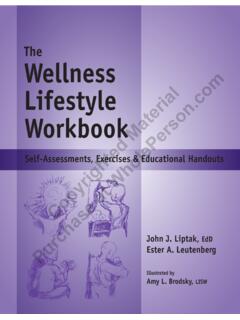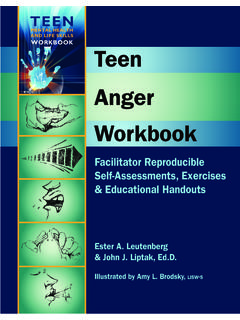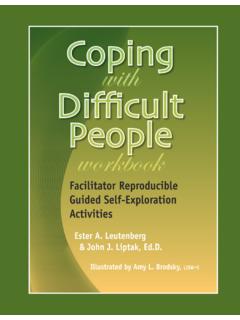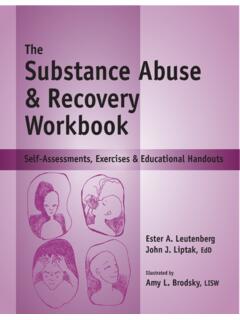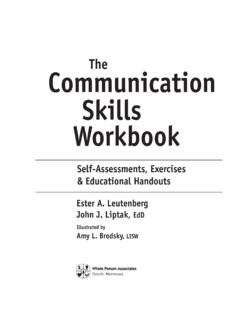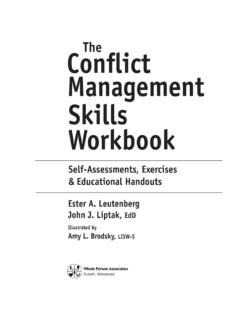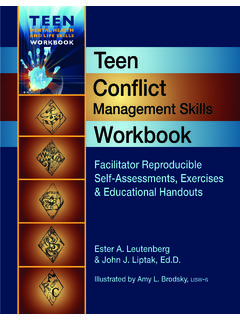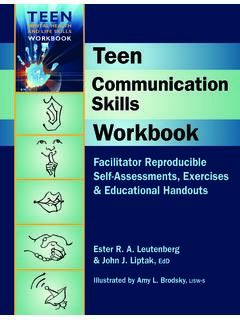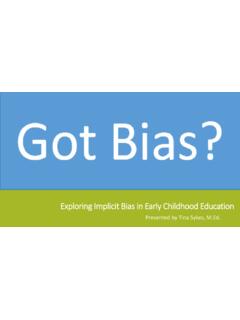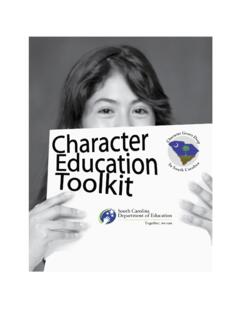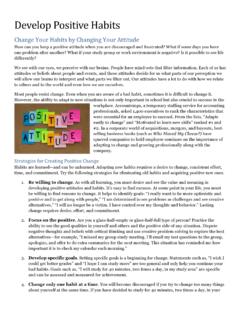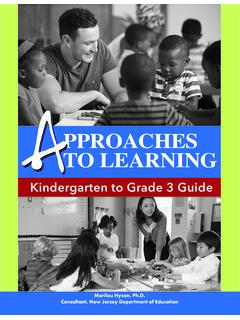Transcription of The Domestic Violence Domestic Survival ... - Whole Person
1 Domestic ViolenceTheWorkbookSelf-Assessments, Exercises & Educational HandoutsJohn J. Liptak, EdDEster A. Leutenberg Illustrated byAmy L. Brodsky, LISWS urvivalDomestic Violence SurvivalTheWorkbookSelf-Assessments, Exercises & Educational HandoutsJohn J. Liptak, EdD Ester A. LeutenbergIllustrated byAmy L. Brodsky, LISWC opyrighted Material Purchase at W. 2nd St., Suite 203 Duluth, MN Domestic Violence Survival Workbook Self-Assessments, Exercises & Educational HandoutsCopyright 2009 by John J. Liptak and Ester A. Leutenberg. All rights reserved. Except for short excerpts for review purposes and materials in the assessment, journaling activities, and educational handouts sections, no part of this book may be reproduced or transmitted in any form by any means, electronic or mechanical, including photocopying without permission in writing from the in the United States of America10 9 8 7 6 5 4 3 2 Editorial Director: Carlene Sippola Art Director: Joy Morgan DeyLibrary of Congress Control Number: 2008942358 ISBN: 978-1-57025-231-0 Copyrighted Material Purchase at This Book (For the professional)Over the past few decades the problems of family Violence and Domestic abuse have been brought to the forefront of our consciousness.
2 The reality is that Domestic Violence occurs in families of all races, cultures, and socio-economic levels. Recognizing early warning signs is critical in the reduction of Domestic Violence . Part of the problem is that Domestic Violence encompasses many different types of abuse: Physical abuse includes slapping, hitting, punching, shoving, kicking, choking, pushing, grabbing, pulling hair, depriving of food, light and/or water, and many other ways of physically harming another Person . Sometimes physical abuse involves being hit with a weapon or an object, or even left alone in dangerous places or tied up and left for periods of time. Sexual abuse is when a partner is forced to participate in sexual situations against his or her will. This can include sexual intercourse when the partner is not fully conscious, has not given consent, or is afraid to say no.
3 This might also include sexual situations in which one partner coerces the other to engage in sexual activities that are not mutually agreed upon. Psychological, emotional or verbal abuse is when one partner threatens, humiliates, excessively blames, puts-down, intimidates or otherwise psychologically hurts the other partner. This may include situations in which a partner is made to feel inferior, stupid or lazy. This type of abuse can also take the form of one partner depriving the other of things they need or keeping them away from other people. Financial abuse occurs when a partner takes financial advantage by cashing checks without permission, taking money and personal belongings, forging a partner s signature, lying about how much money they have, or using deception, scare tactics, trickery or false pretence for financial gain.
4 Multiple forms of abuse are when one partner abuses the other partner in more than one of the ways agree that Domestic Violence is very complex and can take many different forms. Abusers can include spouses, boyfriends and girlfriends, same-sex partners, roommates and friends. It may appear that the obvious and simple solution to this problem is that a Domestic Violence survivor should just leave the abuser and the abusive relationship. Many reasons exist to indicate why this is not always possible or desirable on the part of the abused. The good news is that skills for recognizing and effectively dealing with abusive relationships can be learned. Over the last century many different workbooks, workshops and self-help systems have been designed to help people explore ways of overcoming abusive relationships.
5 In the past twenty years, many research studies have focused on the value of self-reflection and journaling as a way of exploring personal characteristics, identifying ineffective behaviors, and examining thoughts and feelings that lead to these ineffective behaviors. This book is unique in that it combines two powerful psychological tools designed to enhance Domestic Violence coping skills: self-assessment and Material Purchase at This Book (For the professional, continued) Different cultures construct relationships and gender in different ways, For example, some cultures expect relationships to include more possessiveness and even a healthy relationship may score high on the Scales. This does not always indicate a higher incidence of abuse in this community. While the book attempts to be inter-culturally relevant and sensitive, therapists and other professionals must use discretion, sensitivity and cultural competency in their use of these materials.
6 The Domestic Violence Survival Workbook contains five separate sections that will help participants learn more about themselves as well as the impact of Domestic Violence in their lives and the lives of their family members. The five sections of this book are: SYMPTOMS OF ABUSE SCALE helps survivors to explore the extent to which abuse is having on their physical wellness, emotions, thought patterns and detachment from others. TYPES of ABUSE SCALE helps survivors explore and examine their relationship with parents, siblings, grandparents, children, friends and work colleagues. It includes a comprehensive 10-page safety plan. Please stress the comments in the bottom box of each page on how to keep the Safety Plan SAFE! PARTNER behavior SCALE helps individuals identify if they are in a potentially abusive relationship.
7 ELDER ABUSE SCALE helps survivors of elder abuse explore, examine and manage a variety of emotions. SELF-EMPOWERMENT SCALE helps survivors examine if they are successfully moving on from the trauma of abuse and living the life they have dreamed of living. These sections serve as avenues for individual self-reflection, as well as for group experiences revolving around identified topics of importance. Each assessment includes directions for easy administration, scoring and interpretation. Each section includes exploratory activities, reflective journaling activities and educational handouts to help participants discover their habitual, ineffective methods of managing Domestic Violence and exploring new ways to bring about art of self-reflection goes back many centuries and is rooted in many of the world s greatest spiritual and philosophical traditions.
8 Socrates, the ancient Greek philosopher, was known to walk the streets engaging the people he met in philosophical reflection and dialogue. He felt that this type of activity was so important in life that he went so far as to proclaim, The unexamined life is not worth living! The unexamined life is one in which the same routine is continually repeated without ever thinking about its meaning to one s life and how this life really could be lived. However, a structured reflection and examination of beliefs, assumptions, characteristics, and patterns can provide a better understanding, which can lead to a more satisfying life. A greater level of self-understanding about important life skills is often necessary to make positive, self-directed changes in the negative patterns that keep repeating throughout life.
9 The assessments and exercises in this book can help promote this self-understanding. Through involvement in the in-depth activities, the participant claims ownership in the development of positive Material Purchase at is an extremely powerful tool for enhancing self-discovery, learning, transcending traditional problems, breaking ineffective life habits , and helping to heal from psychological traumas of the past. From a physical point of view, writing reduces stress and lowers muscle tension, blood pressure and heart rate levels. Psychologically, writing reduces sadness, depression and general anxiety, and leads to a greater level of life satisfaction and optimism. Behaviorally, writing leads to enhanced social skills, emotional intelligence and creativity. It also leads to improved writing skills which leads to more self-confidence in the combining reflective assessment and journaling, your participants will be exposed to a powerful method of combining verbalizing and writing to reflect and solve problems, becoming more aware of Domestic Violence in their for using the assessments and activities in this book is important.
10 The authors suggest that prior to administering any of the assessments in this book, you complete them yourself. This will familiarize you with the format of the assessments, the scoring directions, the interpretation guides and the journaling activities. Although the assessments are designed to be self-administered, scored and interpreted, it helps for facilitators to be prepared to answer questions about the assessments for participants. With your background and experience, as well as familiarity with the scales, you should be able to clarify for participants any confusing words or phrases. Copyrighted Material Purchase at Assessments, Journaling Activities and Educational HandoutsThe Assessments, Journaling Activities, and Educational Handouts in The Domestic Violence Survival Workbook are reproducible and ready to be photocopied for participants use.
